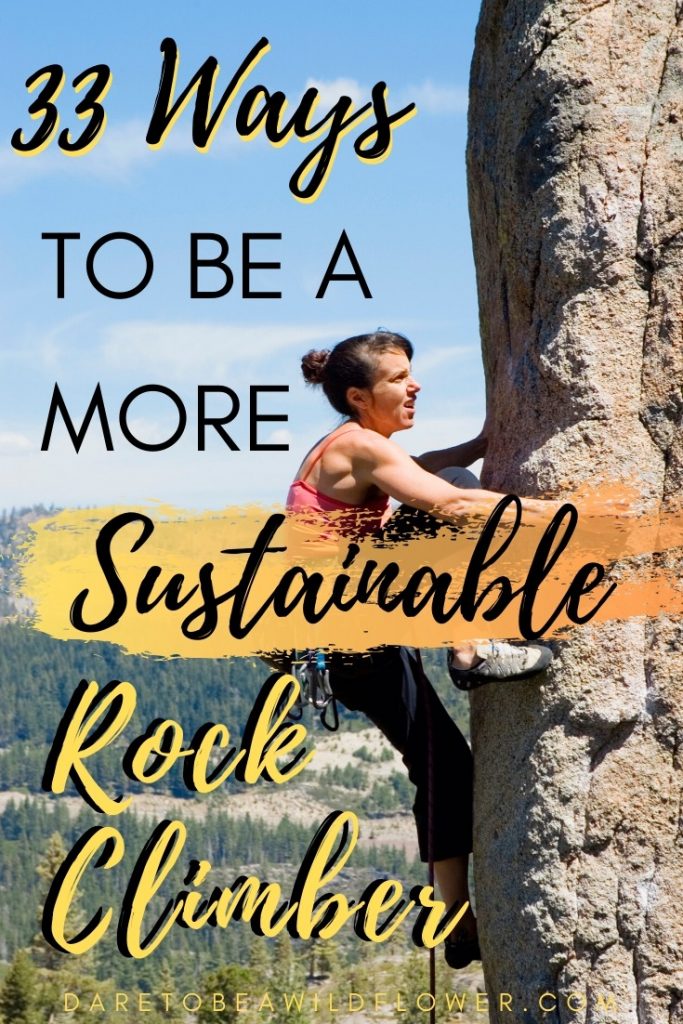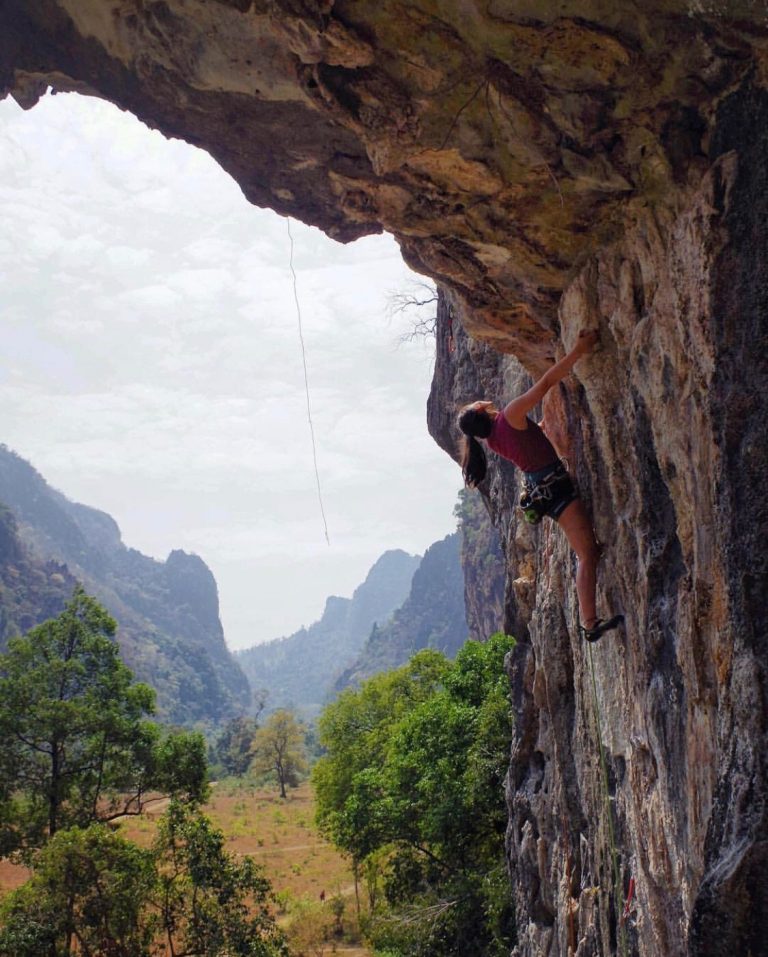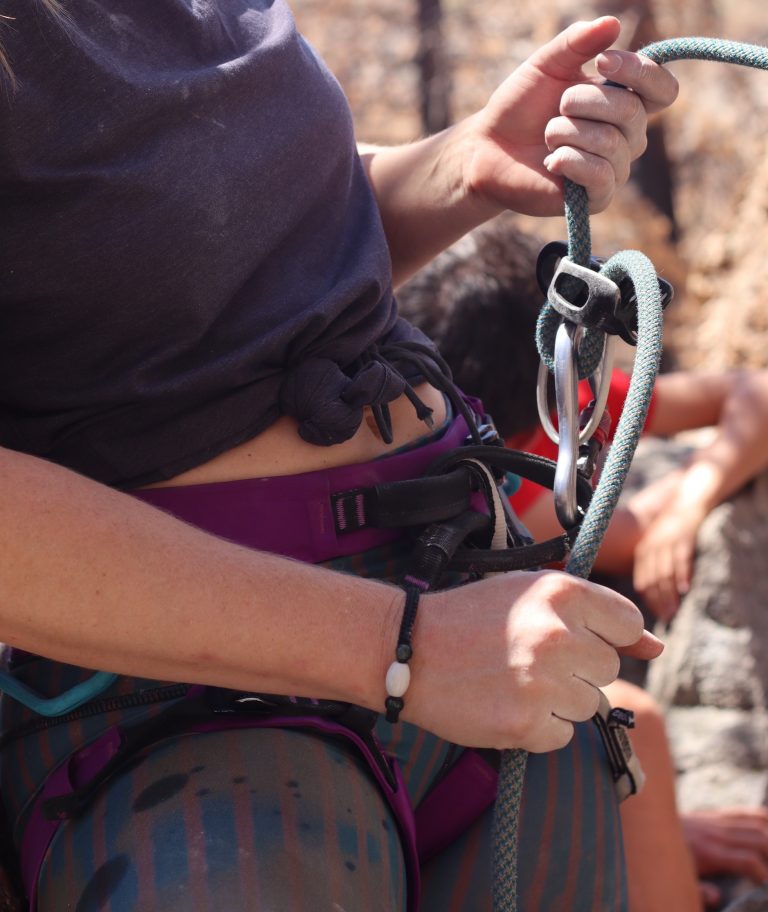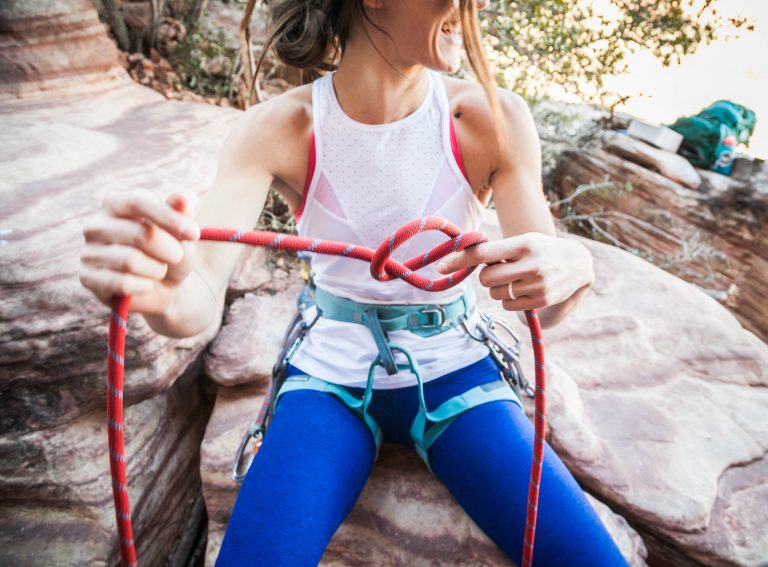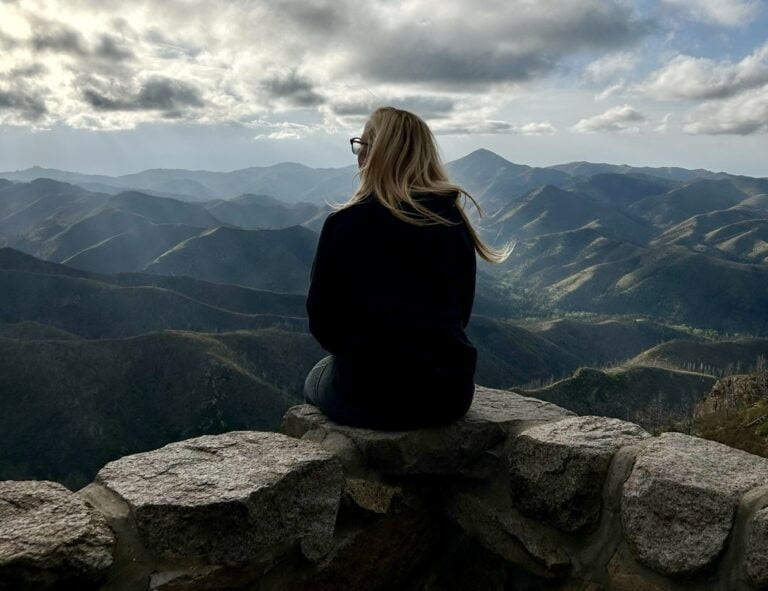#LoveYourCrag: 34 Ways Climbers Can Protect Their Crags and Planet
Dear Climbers, our crags need you. Our planet needs you.
Set an example for the climbing community (and the other folks in your life too) by embracing small changes that help protect your local crag and your planet.
By the time a year has gone by, small changes add up to a big impact and you never know who you may inspire to do the same.
We are the defenders of the Wild.
Here are some small small steps you can take to be a more sustainable rock climber.
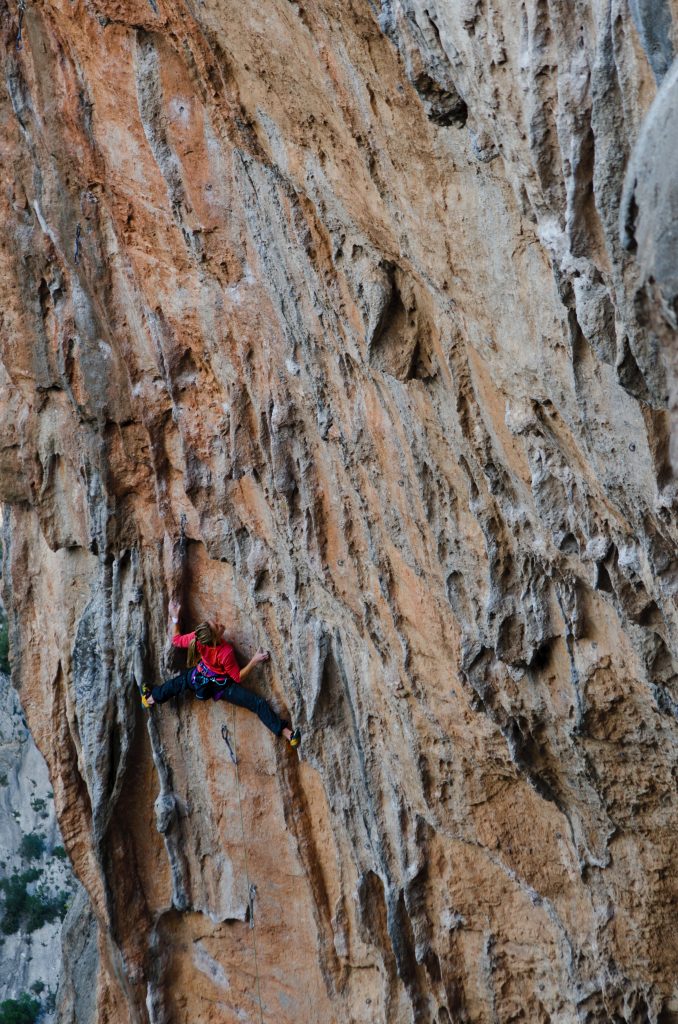
This post may have affiliate links, which means I receive a commission if you choose to purchase through a link I provide—at no extra cost to you. Thank you so much for supporting the work I put into daretobeawildflower.com. You can read my full disclaimer here.
Gear
Mark your climbing gear with nail polish instead of tape
Most commonly, climbers mark their gear to prevent accidentally (let’s give them the benefit of the doubt, right?) swapping gear with fellow climbers at the crag, by wrapping a piece of colored electrical tape around their hardware.
Don’t get me wrong, electrical tape is pretty tough. But it’s not that tough.
Eventually, it starts to shred from wear + tear and ends up polluting our beloved crags with microplastics.
Instead, opt for marking your gear with nail polish.
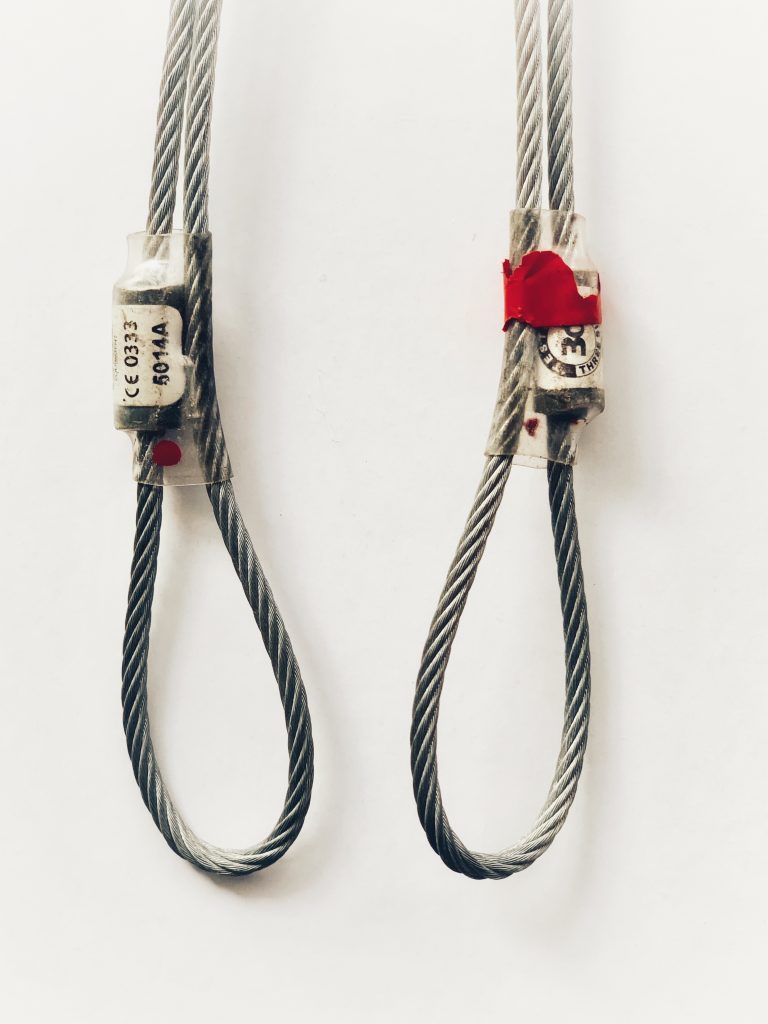
One bottle will last you forever and a simple colored dot sticks nicely onto gear for many years to come.
Also, I bet if you ask five girly-girls that you know, one of them will have at least one color that she’d be happy to give you that she simply no longer uses.
Invest in crack climbing gloves instead of making tape gloves
Climbing tape is a god send (that’s a funny mental image- think about it) for climbers when it comes to keeping our skin on our hands.

Creating your own crack climbing gloves out of tape means that you’re going through more tape, and creating more waste.
Let’s leave the tape for protecting smaller cuts on the skin and save our knuckles in the unforgiving cracks by investing in some crack climbing gloves.
Resole your climbing shoes
Did you know that most rock climbing shoes can be resoled up to three times?
Before you chuck your wonderfully broken-in climbing shoes when you start to notice some holes forming, try resoling your shoes.
Resoling your climbing shoes is:
- a more sustainable option than buying new ones and sending the old ones to a landfill.
- cheaper than buying a new pair of shoes.
- more comfortable! Bypass the dreaded and painful break-in process.
Pro Tip: Get your climbing shoes resoled before they reach the point of no return. Basically, if you can see the upper material starting to peak through the rand- stop climbing in your shoes and immediately send them in for a repair.

How do I resole my climbing shoes?
Mail your shoes into one of the following:
- Yosemite Bum Resole— Orange County, California
- Fastest turn around time in North America (often less than a week!)
- Free shoe stretching service
- Rock and Resole— Boulder, Colorado
- Also repairs approach shoes
- Rubber Room Soles— Bishop, California
- Also repairs approach shoes
It’s a good idea to have two pairs of climbing shoes, so when one pair is getting resoled, you still have some shoes to get sendy in.
Remember, sending in your shoes for repair before you wear through the rand is the goal. Your shoes and your wallet will be grateful.
Care for your gear like you care for your dog
The more we treat our gear with love and respect, the longer they will be in our lives.

Some tips include:
- Pack your climbing shoes at the top of your bag so they don’t get smashed under all your hardware.
- Never lay your climbing rope on asphalt.
- Use a tarp underneath your rope whenever possible to protect it from dirt and water.
- Store your crash pad in the open position to prevent the foam from compressing near the fold.
- Wipe the soles of your shoes off so any small particles of rocks don’t get further embedded into the rubber.
- If you feel the need to lubricate a cam that keeps sticking, be sure to use a dry oil (like the kind that is used on bike chains). You can also try plunging the head of the cam into a bowl of water with a mild soap. Activate it a few times before taking it out to rinse and dry. Viola!
- Wash a dirty climbing harness with some warm water and mild soap. Rinse it with clean water and set it to hang dry in the shade.
- Be sure to store your ropes, slings, and harness out of direct sunlight and away from chemicals.
- Don’t store your climbing shoes in your car or other areas that get hot during the warmer seasons. The heat breaks down the glue that holds the rubber to the upper part of the shoe.
Caring for your climbing gear won’t only help you be a more sustainable rock climber, but it’ll help you stay safe and save your money.
Consider buying used gear
For safety reasons, there’s a fair amount of climbing gear that is not recommend for purchasing second hand. That being said, there’s plenty of gear that you should highly consider buying used like:
- Crashpads
- Hangboards
- Chalkbags
- Guidebooks
- Ropebags
- Backpacks
- Belay Gloves
- Clip Sticks
- Clothing
- Climbing Shoes (if they aren’t too worn and stinky)
- Approach Shoes
- Crampons
- Sleeping Systems (tent, sleeping pad, sleeping bag)
Check out programs like Patagonia’s Worn Wear and REI’s Used Gear online selection to shop second hand gear, save natural resources, reduce the waste that’s associated with the production of things, and keep gear out of landfills. Sounds like a dream to me!
Upcycle your old climbing gear
Has the time finally come to retire that climbing rope?
Well lucky you! Now you can get creative with your rope and upcycle it into a:
The most satisfying upcycling project I’ve ever attempted was this rope rug.
Every sustainable rock climber should make at least one.
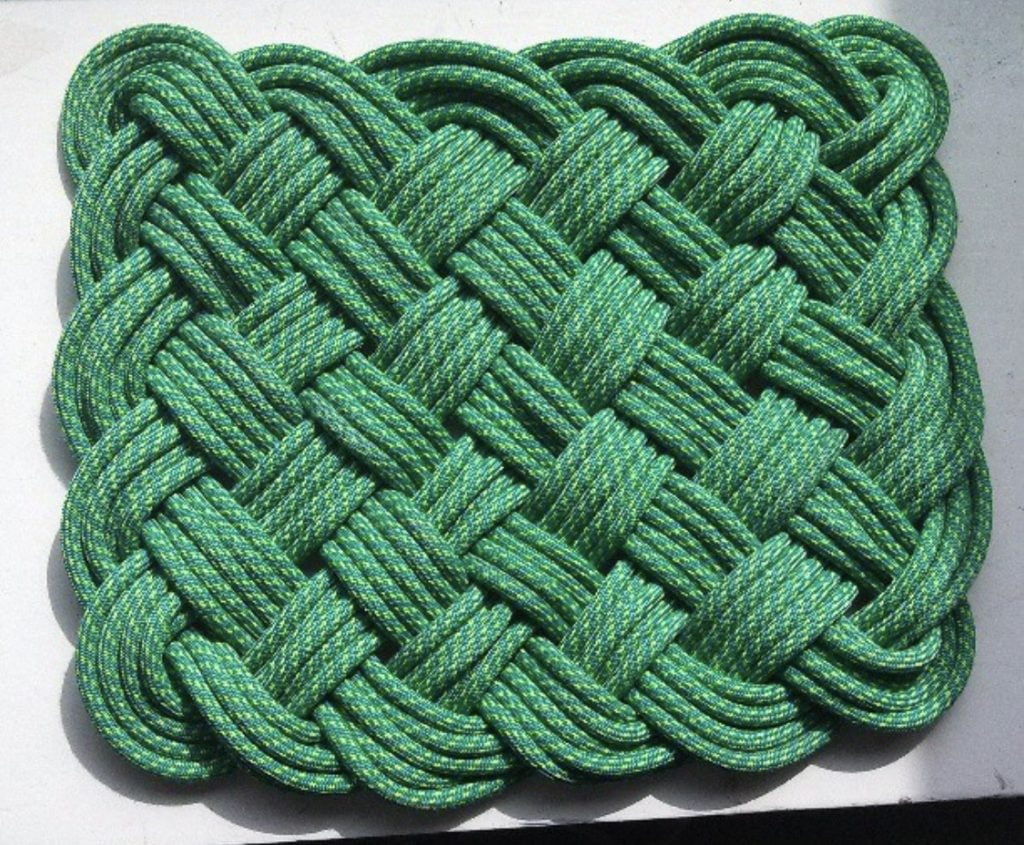
And for the really adventurous DIY’ers out there, here are 15 creative ways to upcycle old shoes.
Every single one of these would be way cooler if they were climbing shoes. Just saying.
Build your own plastic-free gear storage
Okay, now this is too cool not to share!
This guy created a simple, yet effective climbing gear storage unit for less than $35 and no plastic!
What do you think of when someone says, “I’m going to finally organize all my stuff this weekend”?
If you imagine them going out and buying a ton of plastic bins to put all of their stuff in, you’re not alone.
This minimalist approach to gear storage is both eco-friendly and gives you plenty of room to put your own spin on it.
Resell your old climbing gear
Always think of ways you can give those retired shoes or that crash pad a chance at having second life before giving it a one-way ticket to a landfill. #dontfeedthelandfill

Try reselling your (still functional and safe) gear and outdoor clothing on sites like:
- Ebay
- Craigslist
- Poshmark
- LetGo
- OfferUp
If you’re headed into a popular climbing town, there’s a pretty good chance they have gear shops that sell their used gear on consignment.
Supporting local gear shops is super eco-friendly!
9. Host a Gear Swap
Let’s be honest.
Most of us have plenty of toys that are cluttering up the gear closet. You know that dutch oven that you used twice and is now a certified dust collector?
Well that might just get you that pair of rain pants or that ultralight hammock you have been jonesing for.
Host a gear swap at your house, climbing gym, or neighborhood park.
But honestly, this is really just an excuse to have a dance party with your friends. Don’t forget the chips and salsa.
10. Purchase gear that’s Bluesign certified
Have you ever found yourself checking out a new rock climbing harness or a bright, clean rope and noticed it has the Bluesign certification?

Awesome, this is your sign to high five that manufacturer. They have to meet consistent and uncompromising investigations to prove their responsible use of environmentally friendly materials and sustainable practices.
Responsible usage of materials, water, energy, and chemicals is ensured for the safety of the customer, the workers involved in production process, and the environment.
The purpose of Bluesign Certified gear is to hold brands accountable for the environmental and social impact of their textile products.
So if you see that Bluesign certification, know that you are voting with your consumer dollar for more sustainably produced gear.
You’re voting for:
- a healthier planet
- environmentally-friendly production practices
- safer working conditions for employees
- products with less toxins in your home and on your body
11. Shop small
Here are a few rad artists and small businesses you can support for things like chalk bags, clothing, and packs.
- Permagumby– Sendy climbing apparel for femmes.
- Vayu Designs– Chalk bags and packs.
- Non-Virgin Materials– Chalk bags made from up cycled materials.
12. Shop with REI
For more technical gear like carabiners, ropes, quick draws, cams, and rappel devices, I highly recommend shopping with REI.
It’s reassuring knowing that the expensive and incredibly important climbing gear you’re spending your money on is all guaranteed for one year. And if it doesn’t meet your quality standards within that one year period, you can return it. Yes, even after you used it.
REI sells their used gear back to their members for a generous price. Well, they don’t resell gear like ropes, carabiners, slings, and cams for safety and liability reasons.
But you can grab items like crash pads, backpacks, shoes, chalk bags, hang boards and other training tools, as well as outdoor clothing at their Garage Sales.
Every year, REI donates tens of thousands of dollars to outdoor initiatives protecting trails, crags, and public lands.
Plus, they’re incredibly inclusive as they truly do believe the outdoors is for all.
13. Opt for slower shipping when purchasing online
If ordering gear online, opt for the slower shipping option.
When you tell online retailers that you want “no rush delivery”, you’re allowing them to cut back on the amount of packaging, fossil fuels, and CO2 emissions that it will take to get your product to you.
This 5 minute video explains the carbon cost of rush shipping.
Also, be sure to check out this 3 minute video from msn on the same topic but with great ideas for giving us options and holding each other accountable for making sustainable choices as consumers.
Before You Head Out
Bring naked snacks
Go naked!
I mean, shop naked! And by naked I mean sans plastic.
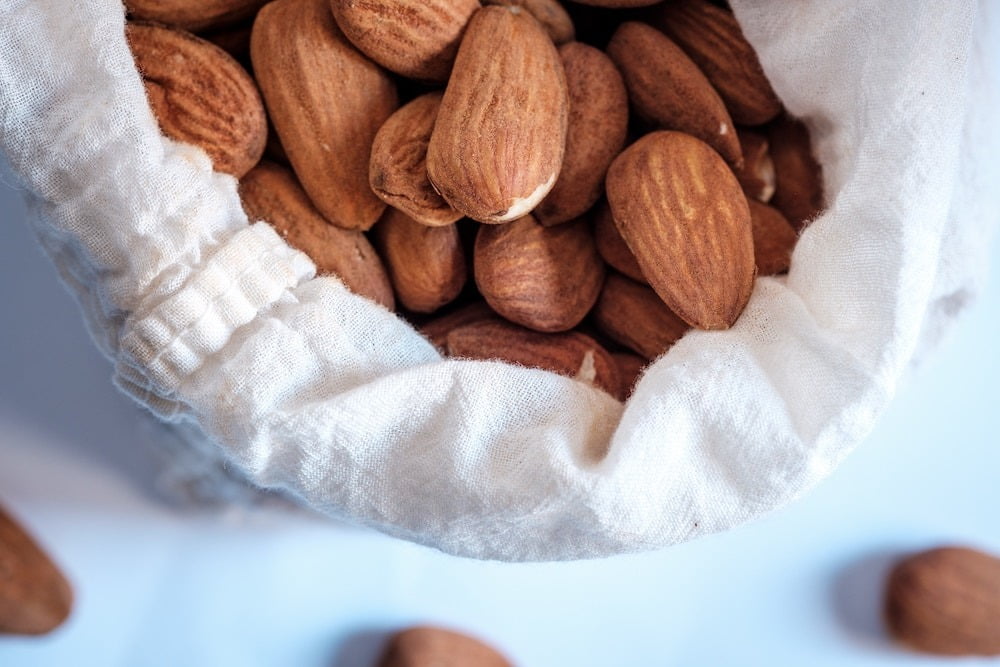
Before you head to the store to stock up on snacks, be sure to grab a few jars or bags to use at the bulk section.
Pro Tip: Be sure to get the tare weight of your container before filling it with snacks.
- Ask a cashier to weigh your container and write that number on a piece of tape on the container itself.
- If it’s a cloth bag, write the tare weight directly on the bag with a permanent marker.
The purpose of this, is so the cashier doesn’t charge you for the weight of your container.
The good news is, you only need to do this the first time and then you’re all set to shop plastic-free and hassle-free in the future.
Repackage your snacks
The best way we can protect our crags from becoming polluted with bits of microplastics, is by keeping plastic out!
How many times have you seen the small corner of a protein bar wrapper lying on the side of the trail? Too many, right?
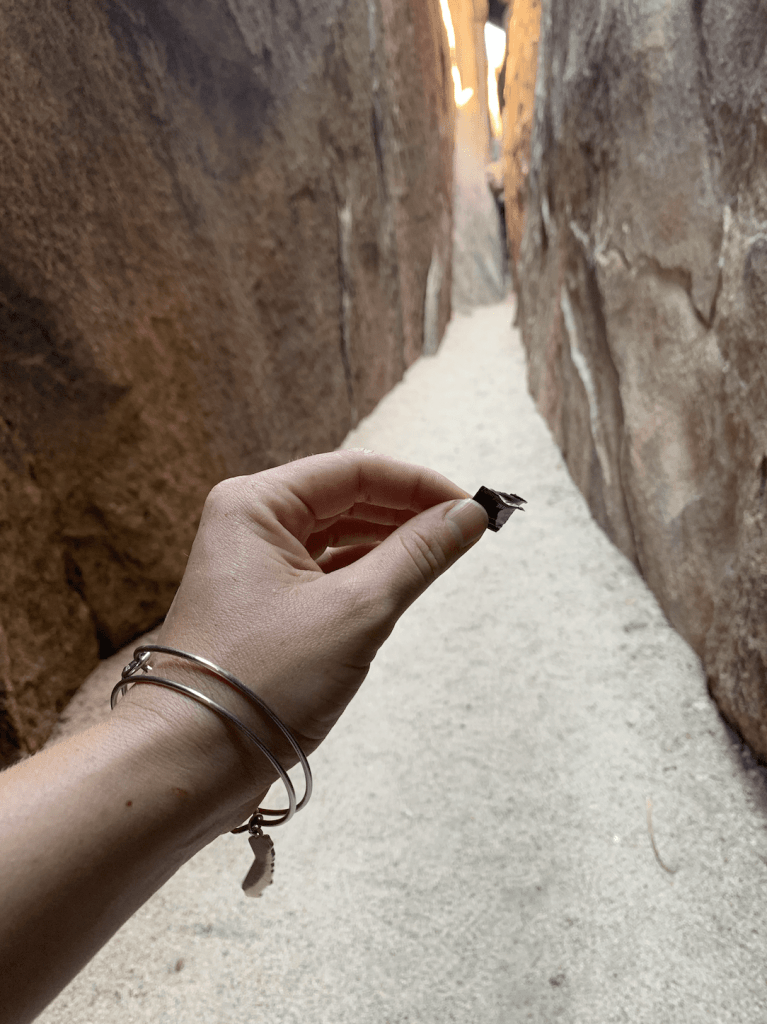
So if you didn’t get the chance to shop for your climbing fuel in the bulk section of your market, the next best thing you can do is repackage your snacks.
If you’re bringing bars, chips, pretzels, sliced fruit, or other yummy snacks that are usually packaged in tin foil or a single-use plastic wrapper or bag, opt to repackage them in a reusable container.
My favorite reusable, snack bag that seals (because all kinds of things can happen inside a backpack full of gear- ahem, chalk bags that open) are the Stasher bags.
I love that they’re BPA-free, plastic-free, toxic-free, and made from silica, a natural resource made from primarily sand.
Stasher is also woman owned and the bags are 100% recyclable if they ever get a hole in them (which, by the way, you’d have to try to do some serious damage to them)!
Prepare a plant based meal
If you haven’t already heard, cow farts are killing the planet. Seriously.
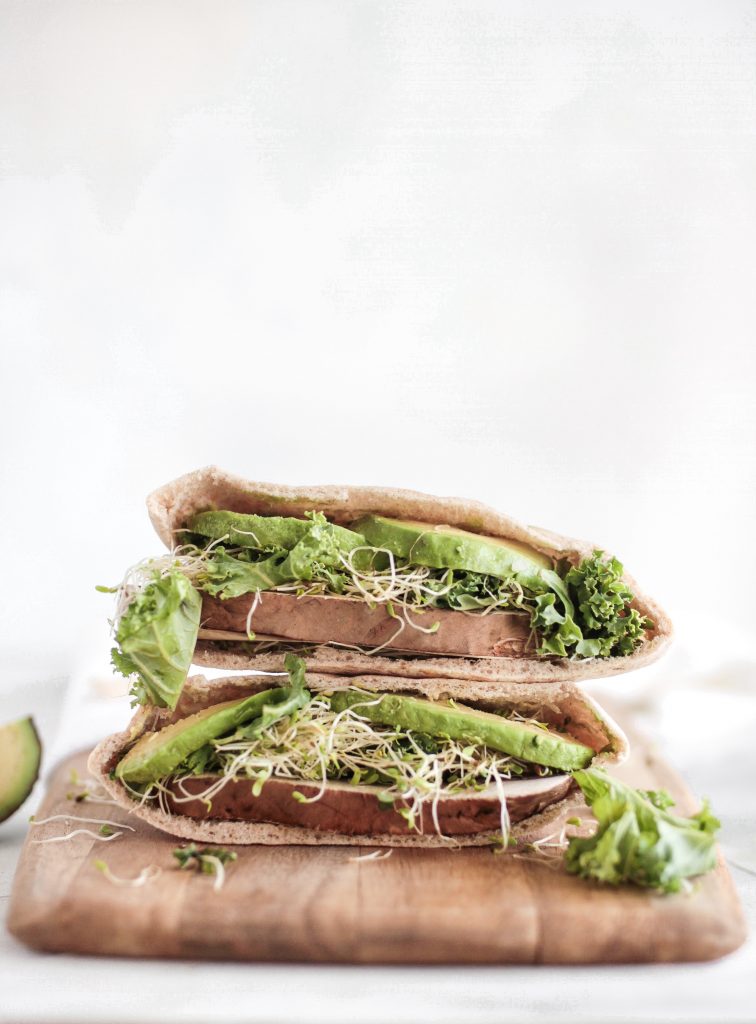
By enjoying a meatless meal, you just:
- saved resources like water, food, land
- produced less CO2 emissions and green house gases
- opted not to hurt an animal for your meal
- avoided contributing to the deforestation of the Amazon forest
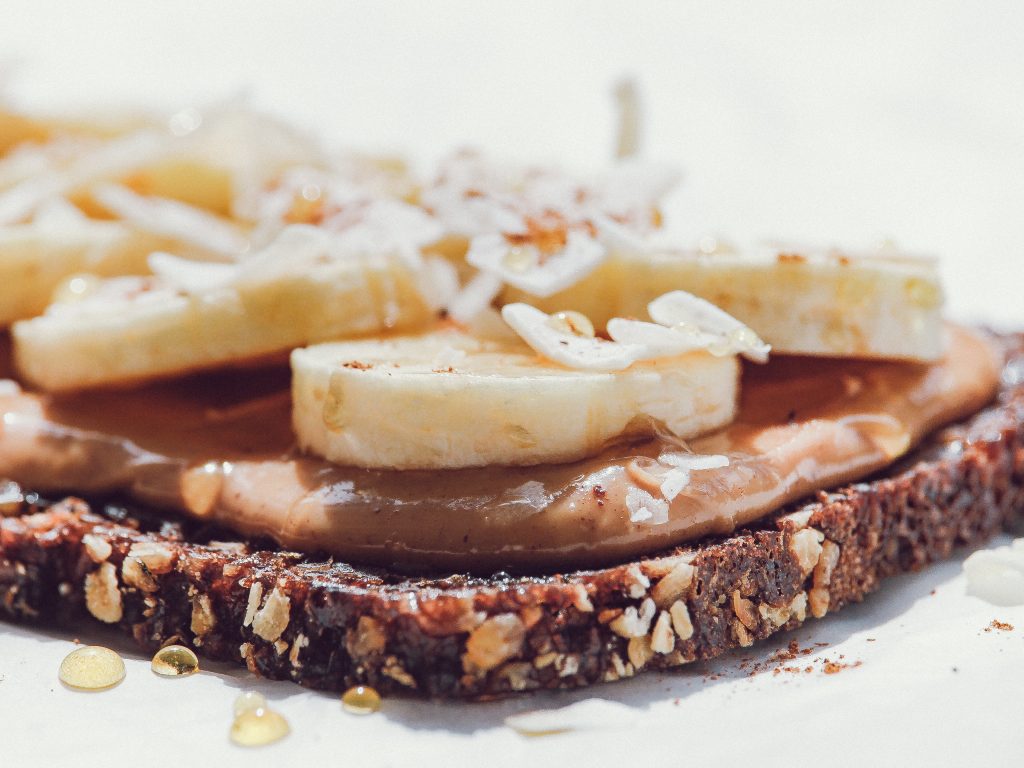
Be a environmental superhero and try packing:
- a good ol’ PB&J
- a veggie sandwich
- corn tortillas and veggies (avocados, cooked potatoes, grilled peppers, etc.)
- snacks on snacks on snacks
- this can include but is not limited to: trail bars, trail mix, fresh fruit, dried fruit, crackers, veggie chips, and peanut butter on everything.
Bonus points if your crag lunch is organic and/or local!
Brew your own coffee

By brewing your own coffee, you’re in control on small factors that add up when it comes to being a sustainable coffee drinker like:
- using a reusable mug
- buying local coffee
- buying organic and fair trade coffee
- shop for Bird Friendly coffee. Migratory birds are being aversely affected by the mass deforestation associated with the coffee plantation industry.
- getting your coffee package-free buy shopping for your beans in the bulk-section #BYObag
- brewing it with a zero-waste method like a french-press
- no plastic or filters wasted here!
- compost the coffee grounds
Fill up large water jugs instead of buying single-use plastic
All-to-often, we stop by a grocery store to pick up a few gallons of water when headed to the crag.
To reduce your use of single-use plastic, try embracing large water containers that you can fill up at a water store (for dirt cheap) before you head out.

If you plan on getting an alpine start and don’t have the time for a water stop in the morning, get it done the day before.
These 7 gallon water jugs are great because they’re:
- BPA-free
- able to reverse the spigot into the inside for worry-free storage and transportation
- not single-use plastic
Check your tire pressure frequently
Have you ever tried to ride a bike with a flat tire? Yeah, the struggle is real.
You have to put significantly more energy in order to go the same speed and distance.
Well, it’s a similar concept with the tires on your vehicle and the amount of gas required.
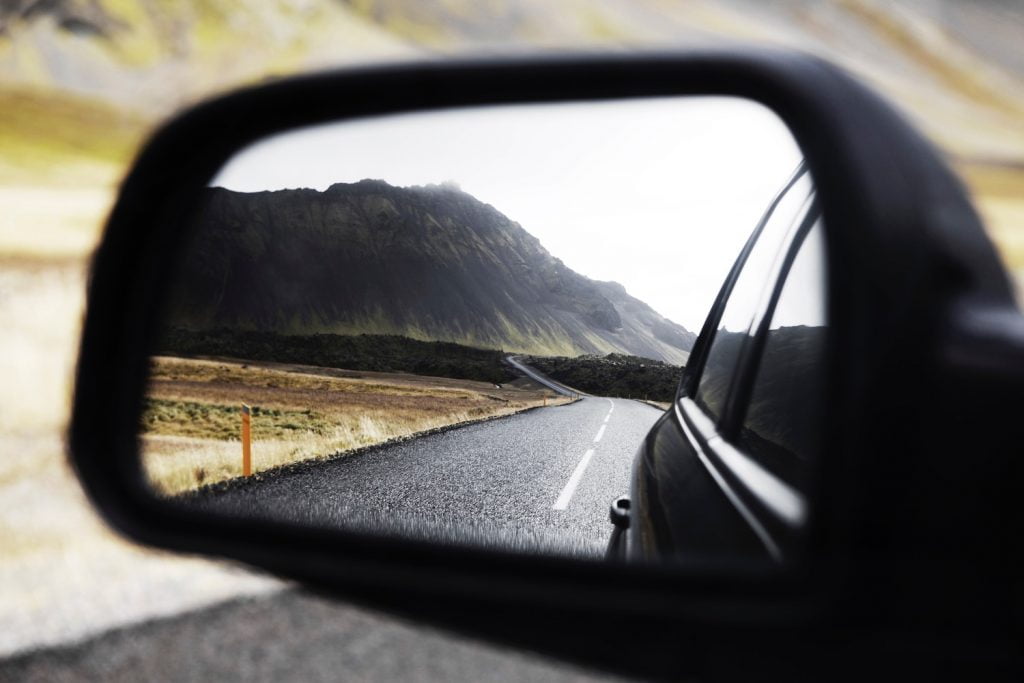
Checking your tire pressure frequently will help you save money on gas, use less fossil fuels, and extend the life of your tires. Fist bumps all around!
Carpool
Wrangle your friends and have a dance party in the car on the way to the crag.
Recent study out of Send It University, indicates this behavior increases relative strength and highly increases chances of flashing.

Carpooling to the crag gives you the opportunity to:
- connect with friends (or soon-to-be friends)
- reduce carbon-emissions
- access the carpool lane
- decrease the congestion of traffic and air pollution
Did you know the average American spends 400 hours every year in their car!
If we all made plans to carpool once a week, we could reduce traffic on the road up to 20%!
More laughs with friends, less traffic. Now that sounds like a better world.
At The Crag
Stay on trail during the approach
I know, I know: shortcuts are so tempting! But walking off trail hurts the microsoil and vegetation, which is an integral part of the ecosystem.
Let’s do our best to stay on trail and avoid making a single track into a double track by rolling with our crew in a single file line on the trail. #loveyourcrag
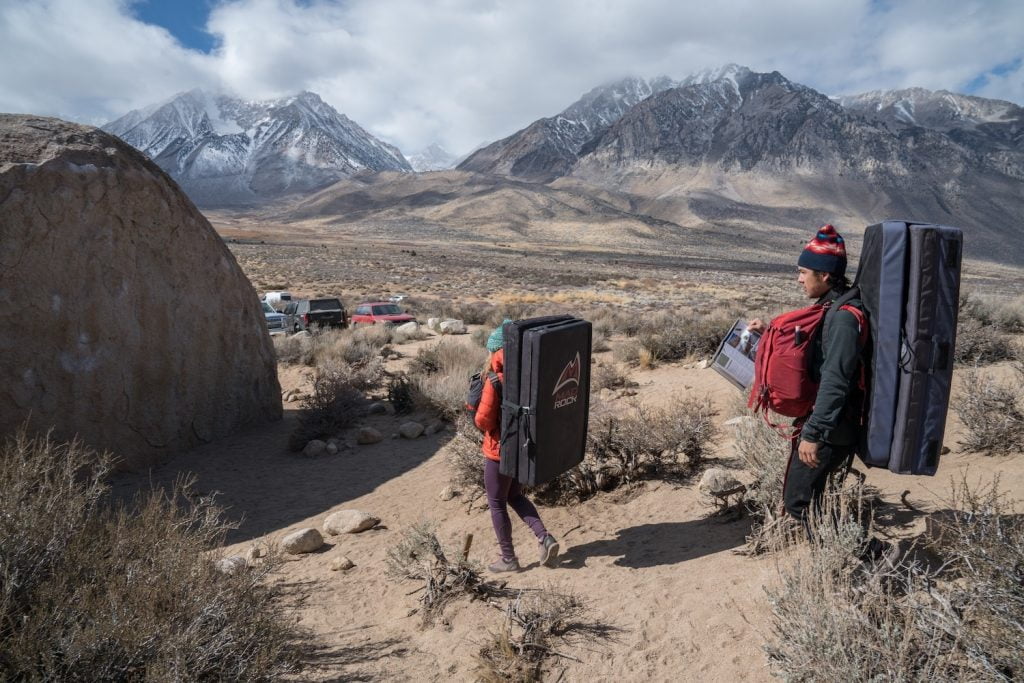
Pack out your toilet paper
As the LNT saying goes, “pack it in, pack it out.”
Rock climbing has totally blown up (with a mighty contribution from social media and the addition of climbing as an Olympic sport) immensely over the past few years.
But how is this affecting our wild spaces?
One major difference I’ve seen on the trails and at my local crags compared to nearly 10 years ago when I first started playing outdoors, is the amount of toilet paper found outside.
To ensure long term sustainability for our crags and public lands, packing out all toilet paper is a necessary practice so we can enjoy our wild spaces for generations to come.
Check out the top 5 reasons why you should pack out your toilet paper.
Don’t yard sale all over the place
When you finally get to the crag, do your best not to spread your gear, clothing, food, and other items all over the place— aka setting up a “yard sale”.
Not only is it inconsiderate towards other climbers at the crag, but you increase the risk of spreading micro trash all over the area, dropping food that wildlife can end up eating (that’s not good for them), and damaging the surrounding vegetation.
Don’t climb on wet sandstone
Wet sandstone is weaksandstone.
If you pull on wet sandstone, the likelihood of the rock breaking off is high!
Protect your crag and leave no trace.
Clean up chalk marks
Remember to bring your chalk brush so you can rub off those chalk ticks before headed to the next boulder or crag.
Cleaning up chalk helps preserve the aesthetic of wilderness. And in the name of not leaving a trace, clean up your mess. 😉

If you feel ready to expose yourself to the Hidden Environmental Cost of Climbing Chalk, then check out this article from climbing.com.
Bring an adventure bag and pick up trash at the crag
What’s an adventure bag?
An adventure bag is a bag that you take on an adventure used to pack out trash that you may find.
Reuse plastic food packaging bags to collect trash, including:
- bread bags
- tortillas bags
- chip bags
- potato bags
- or any other plastic bag that finds it’s way into your life

An obvious way to set an example as a sustainable rock climber, is to bring along an adventure bag.
It’s an essential piece to every sustainable rock climber’s pack.
Be a smart about placing and replacing bolts
Isn’t it nutty to think that many bolts across the US are approaching their 20th or 30th birthday?! YIKES!
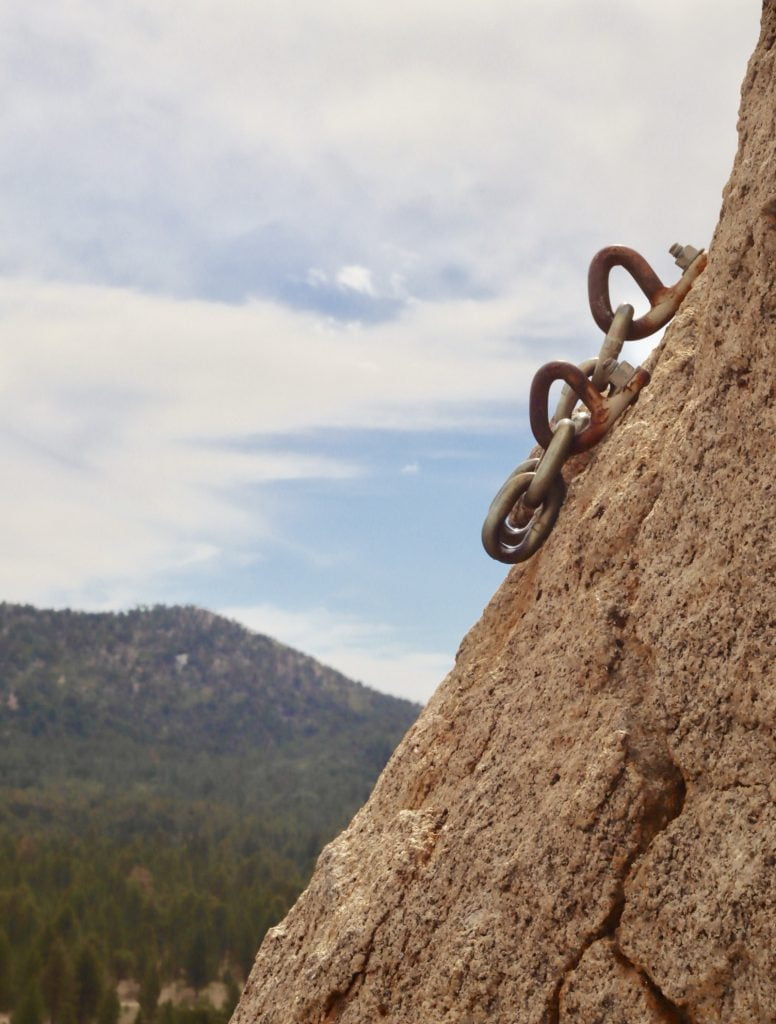
Here are some tips to keep in mind to keep replacing bolts + fixed anchors safe and sustainable:
- Reuse the existing hole.
- Never mix metals.
- Use corrosion-resistant metals like titanium and stainless steel.
- Keep track of what routes & anchors have been replaced and report it to your local climbing organization.
- Follow local ethics + policies.
- And most importantly, ALWAYS get in contact with your local climbing organization, land manager, and/or Access Fund BEFORE you start any work.
It’s our responsibility as community to keep each other safe. Learn more about replacing bolts and fixed anchors at accessfund.org
Stand up for Leave No Trace practices at the crag
Reach out to your fellow climber when outdoor climbing practices are being done in an albeit unintentional, but harmful way.
We need to talk to each other in order to protect this sport, this community, and these beloved lands.
- Plan Ahead and Prepare
- Travel & Camp on Durable Surfaces
- Dispose of Waste Properly
- Leave What You Find
- Be Mindful With Fire
- Respect Wildlife
- Be Considerate of Other Visitors
Takes only picture. Leave only memories.
A Leave No Trace knowledgable rock climber is a sustainable rock climber.
Related Post: What are the Leave No Trace 7 Principles?
Use eco-friendly sunscreen and bug repellent
This tip is especially important for rock athletes climbing into the world of deep water soloing.
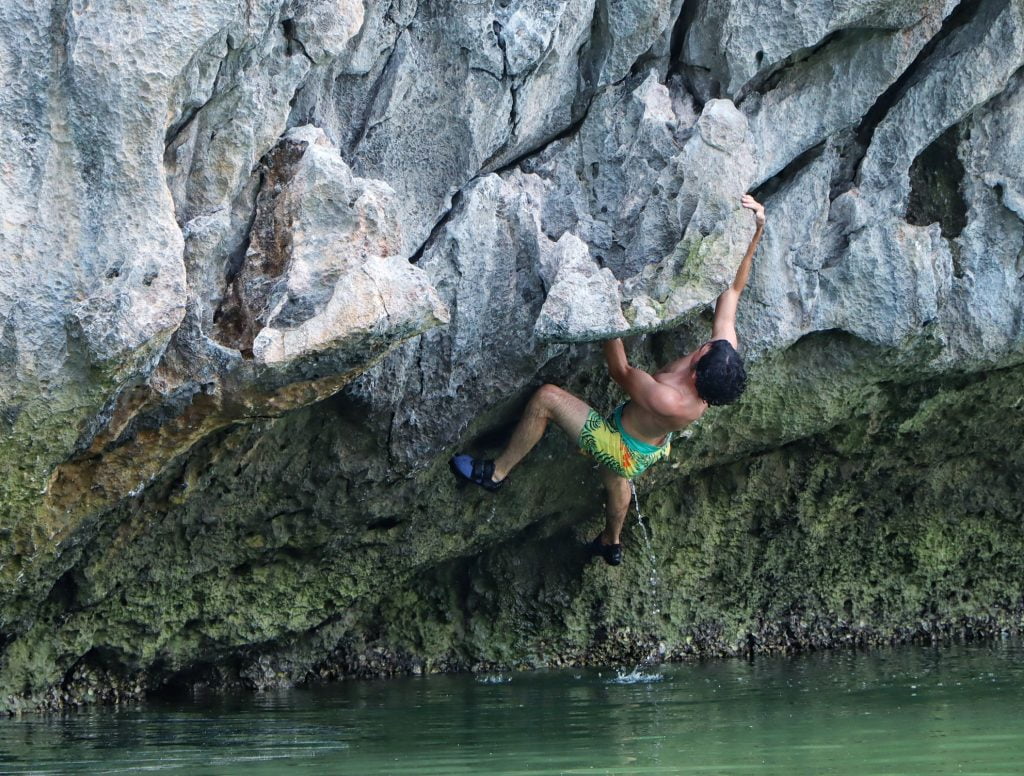
The chemicals found in body products like sunscreen and bug repellents can be harmful, even deadly, to marine life.
According to the National Park Service, an average of 5,000 TONS of sunscreen are added to our oceans each year.
Unfortunately, conventional sunscreens contain nasty ingredients like oxybenzone and octinoxate that trigger deadly viruses within the coral.
Look for sunscreens with active ingredients like:
- titanium oxide
- zinc oxide
Also, be sure the sunblock is “paraben-free” and “non-nano”.
So if you’re headed out to a deep water soloing destination, take that extra step to protect our oceans by bringing along a reef-safe sunscreen.
Keep puppers on leash at busy crags
Keeping your dog on leash at busy crags helps reduce the likelihood of them:
- sitting on someone’s rope
- getting hit in the head with a falling rope
- eating someone’s lunch
- getting into a tiff with another dog
- relieving themselves on or near gear, food, or the crag in general
- running off trail and all over sensitive vegatation

For more tips on craggin’ it with your dog, check out this article by Ruffwear.
After The Hike
Eat local
Making moves to be a more sustainable rock climber can be a delicious endeavor.
Instead of heading to a fast food chain after your epic day of climbing outdoors, opt for a local cafe or restaurant in town that sources their ingredients locally.

According to research, the average piece of food travels 1,500 miles compared to a local piece of food that only travels 100 miles.
It’s a simple (and delicious) choice you can make that will drastically reduce your carbon footprint.
Bonus points if the food is also organic.
Recycle your snack wrappers at REI
Did you know you can recycle your snack packaging with Terracycle at your local REI.
Terracycle believes everything is recyclable and they’re working hard to give a second life to everything from plastic razors to your protein bar wrapper.
- Protein & trail bar wrappers
- Trail mix bags
- Jerky bags
- Chip bags
You get the idea! Give a second life to the plastic packaging that protected and transported your crag snacks bay dropping them in a Terracycle the next time you head into REI.
Take Action
Become a climbing steward
- Volunteer: Connect with your local climbing organization to see how you can get involved with current initiatives at your favorite crag. Check out these steward events and be sure to mark your calendars!
- Register An Adopt-A-Crag: Notify The Access Fund at least 2 weeks in advance of the event and they will blast out an email to help find more volunteers.
- Take Action: Educate yourself on current climbing campaigns and do what you can to help. Stay informed, reach out to federal and state policy makers, and facilitate conversations with your friends to do the same.
- Report A Climbing Access Issue: If an access issue arises, report it here to get the much needed support that’s necessary to fight back.
- Listen to The Climbing Advocate Podcast: Be inspired and educated on climbing advocacy by checking out this awesome resource to learn more about the challenges and successes that climbers have faced in fighting for access. Listen to the conversations of Peter Horgan and climbing advocates as they chat about the advocacy work that is being done on nationwide every single day.
- Available on iTunes and Spotify
Related Post: The Climber’s Pact: The 13 Promises Every Awesome Climber Should Make
Join the Access Fund.
The Access Fund fights for the access and integrity of the lands we climb on, including: rock climbing, ice climbing, mountaineering, and bouldering.
At both a local and a national level their programs include:
- Climbing policy and advocacy
- Stewardship and conservation
- Local support and mobilization
- Land acquisition and protection
- Risk management and landowner support
- Education

Besides being a part of protecting climbing areas, becoming a member of the Access Fund grants you tons of discounts on gear, climbing magazines and events, and event Chrystler vehicles.
I hope you found some inspiration with small steps you can take in order to be a more sustainable rock climber.
What steps do you take to protect your crag and your planet? What do you struggle with the most in your pursuit to be a more sustainable rock climber? Comment below, I’d really love to get this conversation going!
Pin For Later | 34 Ways Climbers Can Protect Their Crags and Planet



